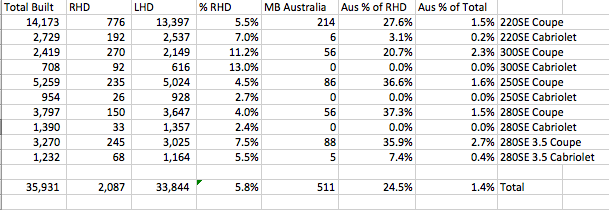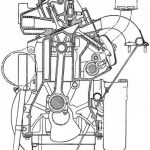The C107 is a bit of an anomaly in the classic Mercedes-Benz range. On one hand it occupies the spot usually reserved for the S Class Coupe. On the other, it was created by lengthening the SL and turning it into a 2+2. This is probably why values were low for years and its only in the last 5-10 that people have started to appreciate the model.
The C107 SLC replaced the superlative W111/W112 coupe and cabriolet range towards the end of 1971. Unlike the previous practice, it was not based on the upcoming W116 S-Class. Apparently, Mercedes-Benz were worried about US regulations effectively banning the SL in the United States. The United States was already the primary market for the SL, so the SLC was developed as an alternative. In the end they put it into production as well. It has a very different character to the stately W111. Being based on the SL, its far more sporty, and has long and low proportions. It also has a much smaller cabin and the interior is not quite up to S-Class levels in some areas. Its a 2+2 rather than a true four seater.
The C107 was replaced by the C126, which reverted back to having the S Class as the basis for the range topping coupe. Yet while the car was back to being based on the S Class, it kept some of the styling cues such as the front grille based on the SL look. It also had sportier seats than the saloon. The look remained with the C140 replacement and continues to this day. So while in some ways the C107 was the anomaly, it left a big imprint in the DNA of the model. The photo below is particularly illustrative, showing a W111 Cabriolet, a C107 and a C126 all lined up together.

The thing all these cars had in common is how expensive they were when new. Outside special editions like the M100 powered cars, they all sat at the top of the Mercedes-Benz range. Starting to look at the C107 and C126 production figures, it’s astounding how many were made. There were almost 63,000 SLCs over about 10 years and 74,000 SECs over about 11. That must have generated an astounding amount of profit for Mercedes-Benz. Both of these models were derivatives of another car and offered no unique running gear.
| C107 | C126 | ||||||||||
|---|---|---|---|---|---|---|---|---|---|---|---|
| 280SLC | 350SLC | 380SLC | 450SLC | 450SLC 5.0 | 500SLC | 380SEC | 420SEC | 500SEC | 560SEC | Total | |
| 1971 | 6 | 6 | |||||||||
| 1972 | 5,562 | 700 | 6,262 | ||||||||
| 1973 | 3,750 | 5,594 | 9,344 | ||||||||
| 1974 | 300 | 864 | 2,961 | 4,125 | |||||||
| 1975 | 1,312 | 589 | 2,993 | 4,894 | |||||||
| 1976 | 1,508 | 671 | 3,802 | 5,981 | |||||||
| 1977 | 1,624 | 822 | 4,569 | 9 | 7,024 | ||||||
| 1978 | 1,553 | 807 | 4,382 | 524 | 7,266 | ||||||
| 1979 | 1,721 | 775 | 4,510 | 937 | 7,943 | ||||||
| 1980 | 1,510 | 79 | 1,737 | 2,228 | 145 | 671 | 3 | 1 | 6,374 | ||
| 1981 | 1,118 | 2,052 | 483 | 945 | 726 | 5,324 | |||||
| 1982 | 4,393 | 4,059 | 8,452 | ||||||||
| 1983 | 3,829 | 6,058 | 9,887 | ||||||||
| 1984 | 1,310 | 6,664 | 7,974 | ||||||||
| 1985 | 787 | 273 | 5,865 | 989 | 7,914 | ||||||
| 1986 | 896 | 2,020 | 4,745 | 7,661 | |||||||
| 1987 | 714 | 1,107 | 5,476 | 7,297 | |||||||
| 1988 | 593 | 1,056 | 5,012 | 6,661 | |||||||
| 1989 | 534 | 1,062 | 5,299 | 6,895 | |||||||
| 1990 | 451 | 1,067 | 5,270 | 6,788 | |||||||
| 1991 | 219 | 499 | 2,138 | 2,856 | |||||||
| Total | 10,646 | 13,925 | 3,789 | 31,739 | 1,615 | 1,154 | 11,267 | 3,680 | 30,184 | 28,929 | 136,928 |
| Total C107: 62,868 | Total C126: 74,060 | Total: 136,928 | |||||||||
The SLC started in 1972 with the 350SLC. The 450SLC would follow mid year, but was only available to the US market until early 1973. The main reason was emissions. The high revving M116 350 engine did not fare well under those regulations and the extra displacement was required to achieve acceptable performance. A similar strategy had been used in the US versions of the W108 and W109 models. The rest of the world version was not hampered by US regulations and offered excellent performance for the day.
This can be immediately seen in the C107 and C126 production figures. The 350 sold very well in 1972 and 1973, but once the 450 came out, sales plummeted and edged into the 800s in good years. Later, the 350 and 450 models were joined by the 280, added in 1974 to address soaring oil prices. This car was a good seller in Europe, but was never offered in North America. The effect of oil prices and the global economy is quite evident as 1974 was the lowest full year production and 1974 not much better.
By the late 70s this had all picked up and Mercedes would introduce the 450SLC 5.0. This model was significant for a few reasons. Mercedes had observed some early success in endurance rallying with private 450SLCs. They were already working on an all-alloy version of their V8 engines for the upcoming W126 S-Class. Leveraging that engine with its lighter weight weight and greater power, plus weight saving through an alloy bonnet and boot lid made for a far more competitive racer. The 450SLC 5.0 was a homologation special – a minimum number of cars were required to show that it was a real production model. It also gave useful real-world experience with the new alloy engines.
The 500SLC would continue this with the new 722.3 four speed transmission and a slight displacement reduction to come in under 5 liters. The 5 liter cars were never available in emissions countries (e.g. USA, Australia etc) or as right hand drive models. There were comparatively few sold. Until about 15 years ago they were criminally cheap, I almost bought one for $3,000 in the USA in 2008 when I lived there. In the end I bought a 250SE coupe for similar money.
To coincide with the launch of the W126 S Class, the 350 and 450 engines were phased out. The 350 was replaced by the 380, which was now also the only model sold in the USA. This was to be a short lived, transition model, as the C126 would come into serious production in late 1981. In Australia, the big coupes went on hiatus with the withdrawal of the 450SLC and it would be until the 1982 model year they would return with the 380SEC.
The C126 models pushed prices and exclusivity up even more. Not only were these cars even more expensive, but the six cylinder option was withdrawn. Buyers had the option of the 380SEC or the 500SEC. Like with the SLC, the small V8 wasn’t a great seller. It was the only model offered in the United States for the 1982 and 1983 model years which skew the figures somewhat. When Mercedes-Benz realized how much money they were losing to grey imports they made the 500SEC available for the 84 and 85 model years. Sales of the 380 dropped right back and the 500 had a noticeable increase. The USA 84 and 85 model year correspond to production from mid 83 to mid 85. This is pretty apparent in the C107 and C126 production figures.
The W126 facelift in mid 1985 was extended to the SEC. The 380SEC was replaced by the 420SEC, the 500SEC was upgraded and a new rage topping 560SEC was introduced. I’ve covered the story of the 560 engine in this article. Not only was the 560 the flagship, it was also the only one offered in the United States. Sales were very good despite the eye watering prices. In 1991, the 560SEC was over AUD$250,000 in Australia. The 420SEC was never a good seller as compared to the 500 or 560. This was the same story with the 420SL, yet the 420SEL was made available in emissions markets and sold strongly. The M117 engine cars were always the best sellers, with almost 70% of SLCs and SECs so equipped.
It is also interesting to compare the sales numbers with the mid size coupes. The big coupes were significantly more expensive than the mid size cars. Prices varied, but taking 1982 as an example, a 280CE was AUD$44,500 and a 380SEC $77,500. Yet, in most years less than 50% more mid size cars were sold. This figures really highlight how little competition there was for Mercedes-Benz at the S-Class level in the 70s and 80s. Rolls Royce was a big step up, BMW and Jaguar were a big step down and Lexus, Audi and others were not even playing in the market.
The C107 and C126 production figures also help illustrate that despite how good these cars are, the prices are still somewhat reasonable. Certainly they have risen in the last 24 months in the frothy classic market, but even at current conditions they were not unreasonable for the qualities of the car. And if they settle back a little as is probably likely, it makes them all the more affordable.
I’ve been lucky enough to own four of these cars over the years. I probably have more miles behind the wheel of a C107 or C126 than any other car. I now have one of each and can’t see myself letting either go.





Leave a Reply